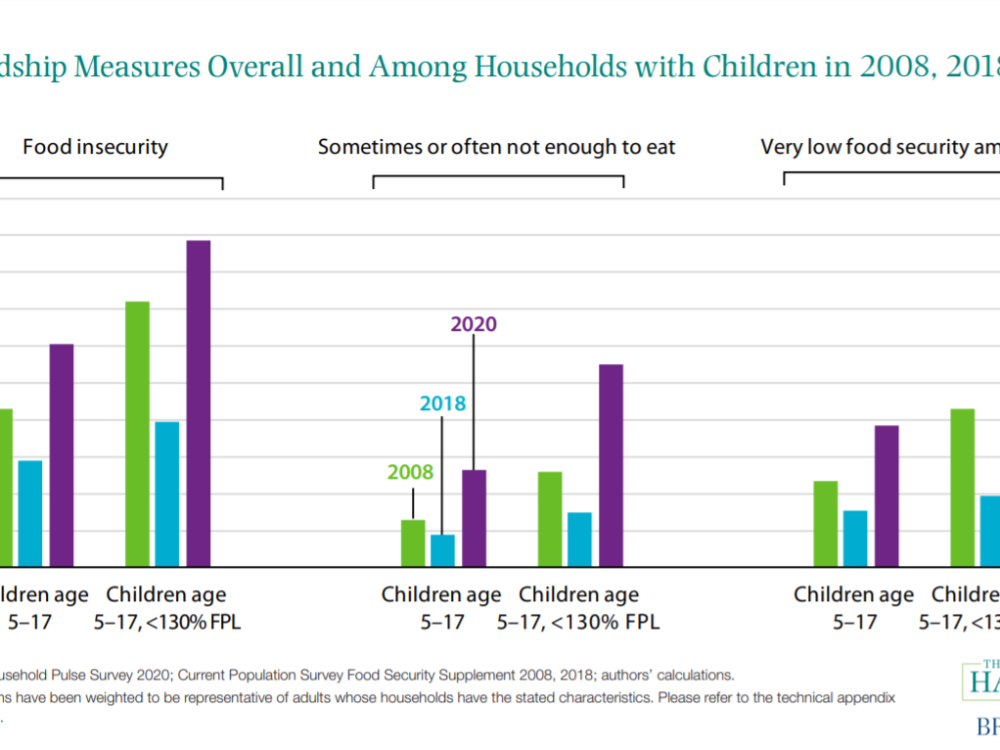In Charts of the Week this week, food hardship during coronavirus; the estate tax; and the diversity of America’s young generations.
FOOD HARDSHIP AMID CORONAVIRUS
 New research from the Hamilton Project at Brookings examines the effects of the Pandemic EBT program, designed to help families whose children were no longer able to meet their nutritional needs due to school closures. The chart above shows the rate of measures of food hardship among children in three time periods, with 2020 far outpacing the trough of the last recession in 2008. On the program’s effects to date, the researchers conclude that “Pandemic EBT reduced food hardship experienced by low-income families with children and lifted at least 2.7-3.9 million children out of hunger.”
New research from the Hamilton Project at Brookings examines the effects of the Pandemic EBT program, designed to help families whose children were no longer able to meet their nutritional needs due to school closures. The chart above shows the rate of measures of food hardship among children in three time periods, with 2020 far outpacing the trough of the last recession in 2008. On the program’s effects to date, the researchers conclude that “Pandemic EBT reduced food hardship experienced by low-income families with children and lifted at least 2.7-3.9 million children out of hunger.”
AN ESTATE TAX TO ADDRESS WEALTH INEQUALITY
Growing inequality and rising federal debt are threats to long-term prosperity, according to researchers Bill Gale, Christopher Pulliam, John Sabelhaus, and Isabel Sawhill. In a new policy brief, these authors consider the policy of expanding the estate tax, a tax on the capital gains that decedents avoided paying while alive. Using a new model, the authors calculate revenue estimates based on current law and three previous estate tax scenarios. “The long-term threats of unsustainable federal debt, rising inequality, and the need for government investments should compel policymakers to seek new ways to raise substantial revenue from the well-to-do,” they write. “An expanded estate tax would raise large amounts of revenue, be highly progressive, and directly target a major source of wealth inequality.”
YOUNG PEOPLE ARE MORE DIVERSE THAN EVER
 Last week, we noted that according to William Frey’s research, the millennial, Gen Z, and younger generations now make up more than half of the total American population. Frey also explained that the younger generations are more racially diverse than ever, and are coalescing around economic and social disruptions brought about by the coronavirus pandemic and protests for racial justice following George Floyd’s murder. “The fact that nearly two-fifths of millennials and Gen Z are Black and brown,” Frey writes, “makes these issues deeply personal for them. The broad coalition of all races—including whites—in this movement suggests a joining of disparate interests toward making fundamental changes in racial justice.”
Last week, we noted that according to William Frey’s research, the millennial, Gen Z, and younger generations now make up more than half of the total American population. Frey also explained that the younger generations are more racially diverse than ever, and are coalescing around economic and social disruptions brought about by the coronavirus pandemic and protests for racial justice following George Floyd’s murder. “The fact that nearly two-fifths of millennials and Gen Z are Black and brown,” Frey writes, “makes these issues deeply personal for them. The broad coalition of all races—including whites—in this movement suggests a joining of disparate interests toward making fundamental changes in racial justice.”

Commentary
Charts of the Week: Food hardship; estate tax; America’s diverse younger generations
August 7, 2020